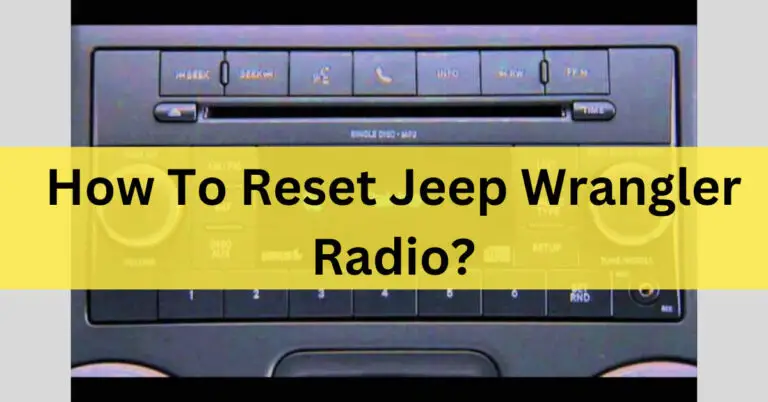Jeep Wrangler passenger seat will not recline [How to solve]
Many people adore the Jeep Wrangler, an iconic and tough off-road vehicle, for its adaptability and spirit of adventure. However, like any vehicle, it is not immune to mechanical issues.
One common problem Jeep Wrangler owners may encounter is a passenger seat that will not recline. If you are in this situation, don’t worry, we’ve got you covered.
You can Troubleshoot by checking for obstructions, testing reclining mechanisms, lubricating, inspecting handles/cables, verifying seat tracks, or seeking professional help.
In this article, we will explore the potential causes and provide a step-by-step troubleshooting guide to help you resolve the issue.
Potential Causes of a Non-Reclining Passenger Seat:
1. Obstruction:
The first thing to check is whether any obstruction prevents the seat from reclining. Look for objects, debris, or personal belongings that may have fallen between the seat and the backrest, blocking the reclining mechanism.
2. Jammed Reclining Mechanism:
Over time, the reclining mechanism may become jammed due to dust, dirt, or a lack of lubrication. It can prevent the seat from reclining smoothly or cause it to get stuck in one position.

3. Broken Reclining Handle or Cable:
The reclining mechanism is operated using a cable or handle. If either of these components is damaged or broken, the seat may not recline.
4. Seat Track Issues:
The passenger seat’s track, which allows it to move forward and backward, may also affect the reclining function. If the track is damaged or obstructed, it can prevent the seat from reclining.
5. Electrical Malfunction:
In newer Jeep Wrangler models equipped with power seats, an electrical issue or a blown fuse could be the reason behind the non-reclining seat.
Troubleshooting Steps:
Step 1: Check for Obstructions:
Start by thoroughly inspecting the area around and under the passenger seat. Remove any objects or debris that may be hindering the seat’s movement.
Step 2: Test the Reclining Mechanism:
Attempt to recline the seat using the reclining handle or switch (if applicable). If you feel resistance or notice the seat is not moving smoothly, proceed to the next steps.
Step 3: Lubrication:
Apply a suitable lubricant to the reclining mechanism’s moving parts, such as pivot points and hinges. It can help loosen any debris or dirt and improve the reclining function.
Step 4: Inspect the Reclining Handle and Cable:
Check the reclining handle and cable for any signs of damage or wear. If you find any issues, consider replacing the damaged components.
Step 5: Verify Seat Track Functionality:
Ensure the passenger seat’s track is in good condition and free from obstructions. If necessary, clean and lubricate the way to allow smooth movement.

Step 6: Power Seat Electrical Check:
If your Jeep Wrangler has power seats, inspect the electrical connections and fuses related to the reclining function. Replace any blown fuses and fix any loose or damaged connections.
A non-reclining passenger seat in a Jeep Wrangler can be a frustrating issue, but it is often fixable with some basic troubleshooting.
By following the steps mentioned in this article, you can find and address the cause of the problem, restoring the functionality of your passenger seat and ensuring a comfortable and enjoyable driving experience for both the driver and passengers.
How to Recline Seat in Jeep Gladiator?
Reclining the seat in a Jeep Gladiator is a straightforward process that allows you to adjust the seat’s angle for a more comfortable driving or riding experience. Here’s how to recline the seat in a Jeep Gladiator:
- Locate the Reclining Lever: Look for the reclining lever on the side of the seat. It is typically positioned along the lower portion of the seat, near the front.
- Pull the Reclining Lever: Pull the reclining lever upward to recline the seat. It will release the seatback, allowing you to adjust the angle.
- Lean Back or Forward: With the reclining lever pulled up, lean against the seatback to recline it to your desired angle. If you wish to sit upright, push the seatback forward until you find a comfortable position.
- Lock the Seatback: Release the reclining lever once you have set the seatback to your desired angle. The seatback should now be locked in place.
- Test the Seat Adjustment: Confirm that the seatback is securely locked in the chosen position by gently pushing and pulling on it. Ensure it remains stable and does not move unexpectedly.
- Fine-Tune the Position: If needed, you can make minor adjustments to the seatback angle by repeating the steps above. Find the angle that best suits your preference and provides maximum comfort.
- Adjust Lumbar Support (if equipped): Some Jeep Gladiator models have lumbar support adjustments for added comfort. If your Gladiator has this feature, you can adjust the lumbar support to enhance your seating position further.
It’s important to note that while adjusting the seat, always do so when the vehicle is parked or at a complete stop. Avoid making seat adjustments while driving to ensure your safety and other road users.
Frequently Asked Questions:
1. What could be causing the passenger seat in my Jeep Wrangler not to recline?
Several things can contribute to this issue, such as obstructions, jammed reclining mechanisms, broken handles or cables, seat track problems, or electrical malfunctions (in models with power seats).
2. Can I fix the reclining issue, or should I seek professional help?
The extent of the problem and your mechanical expertise will determine whether you can resolve it yourself. It’s best to consult a qualified mechanic or dealership for more complex issues or unsure.
3. Is continuing to use the passenger seat safe if it won’t recline?
If the non-reclining seat does not hinder your ability to drive safely and comfortably, you can continue using it. However, addressing the issue is recommended for passenger comfort and to prevent potential complications.
4. How much would repairing a non-reclining passenger seat in a Jeep Wrangler cost?
The cost of repairs can vary based on the cause and the parts involved. Simple fixes like removing obstructions or applying lubricant might be affordable, but more extensive repairs could be costlier.
Conclusion:
A non-reclining passenger seat in a Jeep Wrangler can be inconvenient and uncomfortable for both the driver and passengers. To determine the cause of the issue, it’s essential to go through a systematic troubleshooting process, checking for obstructions and inspecting the reclining mechanism.
Lubricating moving parts and examining handles, cables, and seat tracks can often resolve minor problems. If your troubleshooting efforts don’t lead to a solution, it’s advisable to consult a qualified mechanic or take the vehicle to a dealership.
They have the expertise to diagnose and fix more complex seat reclining issues and ensure that the seat is safe and functional for all occupants.







